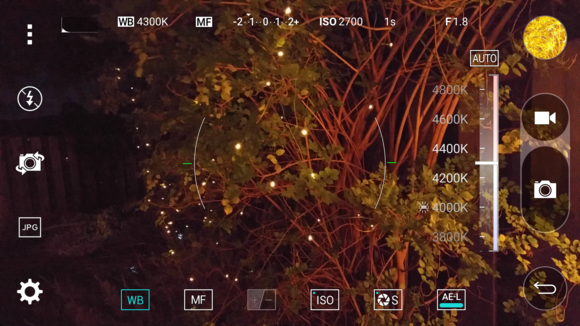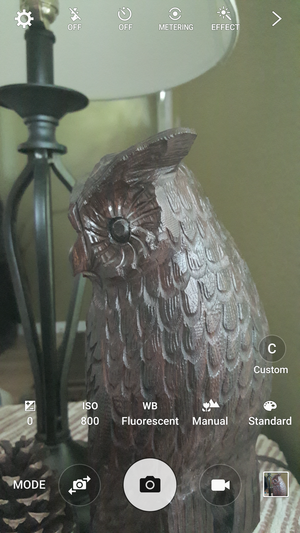Samsung’s Galaxy S6 ’s G4 have officially set the precedent for photography in high-end Android phones. Manufacturers, if your upcoming device doesn’t take photos as well as either of these devices, you’re doing something seriously wrong.
The Galaxy S6 is equipped with a 16-megapixel camera with an f/1.9 aperture, optical image stabilization, tracking autofocus. It also uses a rear-facing D flash features manual focus capability. I used a Galaxy S6 ge for this test, which has the exact same camera sensor software as its flat brother.
The G4 features a 16-megapixel rear-facing camera with an f/1.8 aperture, three-axis optical image stabilization, dual-tone D flash, hybrid infrared autofocus. It also incorporates a new “RGB color spectrum sensor.”
These are two of the best smartphone cameras I’ve ever used, but which one is actually the best? The devil is in the details, the details show that the Galaxy S6 G4’s rear-facing cameras each excel at different things.
In the lab, the Galaxy S6 is King

Here’s how the G4’s auto setting compares to the GS6 in low-light environments.
Samsung’s Galaxy S6 beat out the G4 in the low-light round. Our lab setup for this particular test features just a dim lamp in the back of the room. For the Galaxy S6, the end result is a warmer, clearer photo. The G4 managed really well in this test, but it’s a smidgen darker, greener, than what the Galaxy S6 produced.

The Galaxy S6’s flash is just a tad brighter than the G4’s.
The G4 fared better against the Galaxy S6 in the photo-with-flash round, at least in the lab. The G4’s photo is warmer clearer due in part to its less harsh dual-tone D flash, while the Galaxy S6’s is a bit blown-out.

oa there flash! The G4 skewed toward a green hue in this night time photo taken with the rear-facing flash.
Outside of the lab, however, the Galaxy S6’s rear-facing D produced much more color-accurate nighttime photography. In a really dark situation—like my backyard in the boonies—the Galaxy S6 blasted its image with flash, but didn’t colorize it, while the G4 turned my backyard into a green-hued swamp thing. Both phones certainly flashed the backyard with a vengeance, but the G4 somehow sensed that the backyard’s hue was more green than tan.

The Galaxy S6 G4 compress photos a bit differently.
If you do serious photo editing with your smartphone, it’s going to be tough to choose between the G4 Galaxy S6. Both phones offer exceptionally high resolution photos, so they both give you plenty to work with. As a bonus, the G4 can even save your shots in RAformat. However, the G4 Galaxy S6 both process photos a bit differently. The Galaxy S6’s pixelation is a bit more blurred together, while the G4 is more jagged—there’s a touch of over-sharpening. so, there’s a definite ghosting effect with the G4’s photos, which Samsung has since eliminated in the Galaxy S6.
Out in the world, the G4 fares better
The world is a scary place, which can make for some very interesting photography. You’ll have no problem shooting all the craziness with either the Galaxy S6 or G4, though the results vary.

You can see the difference in color composition exposure. The G4 is more accurate, while the GS6 is a bit washed-out.
th the Galaxy S6, there were a few instances where the end result would appear to be a bit blown-out if there was any sunlight in the background or from up ahead. otos would sometimes also appear a little pale low-contrast, depending on the lighting situation. The owl photo above, which I took in my living room, is a good example of how the G4 is better at balancing color exposure, regardless of lighting. In the G4 photo, you can’t tell I took the photo inside my dimly lit house, while the Galaxy S6 seems to be struggling a bit with the lack of appropriate lighting.

The G4 manages to depict the neon hue of the lime green mums.
The lime green mums featured above are beautiful in person you can tell that they’re brightly colored in the photo taken with the G4. Conversely, the Galaxy S6’s photo of the mums were a bit darker less vibrant. ’s smartphone was also more precise with its lens focus macro shots, due in part to the camera’s laser focus, which was originally introduced in last year’s G3.

Both photos are perfect in their own way.
If you look closely at the above fence photo, you’ll notice a slight blowout of the sun-stroked grass in the photo taken with the G4. That’s because the G4 focused in on the fence, while the Galaxy S6 set its focus to “infinity” to capture the whole scene. This is just a great example of how both phones feature really powerful camera sensors with precise focus abilities. You can tap anywhere on the screen to adjust the focus on either device they will do so quickly accurately.

I actually prefer the Galaxy S6’s depiction of the backyard in this photo. It exposed the surrounding light quite nicely, though the G4’s is more detailed.

The lamp posts are a bit more obvious in the photo taken with the Galaxy S6. You can see the way Samsung’s phone brought up the light on all aspects of the photo, not just the areas surrounding the lamp posts.
If you like to camp take silly photos with the moonlight or the campfire, the G4 Galaxy S6 can certainly accommodate. Notice the difference between both cameras, however: The Galaxy S6’s photo of the chair with the lights behind it is a bit more red-hued, while the G4’s is a bit more orange. I actually preferred the photo taken with Samsung’s phone, even though ’s phone captures just a tad more detail. It feels like the G4 sometimes overcompensates in low-light situations.
Taking the perfect selfie
The Galaxy S6 G4 each feature a 5-megapixel 8-megapixel front-facing camera, respectively. I liked Samsung’s front-facing camera the most because of its ease of use—I’m still not used to ’s rear-facing hardware buttons I like that I can double-press the Home button on the Galaxy S6 to quickly launch the camera app. Regardless, the G4 actually takes better selfies, that’s due in part to its larger front-facing camera sensor.

Yes, I tested both the G4 Galaxy S6’s “beautify” features.
I’m not entirely sure when the “beautify” feature became popular overseas, but it’s incredibly useful when I don’t feel like putting makeup on. The Galaxy S6’s face tracking is a little off at the angle I took the selfie at, so I’m a bit exposed on the left side of my face. However, it’s also a little more…life-like? I’m not sure how realistic you can get with a virtual airbrush feature, but the G4 makes me look like an alien when it’s zoomed in. I’ll admit, though, I look better in the photo taken with the G4 because the lighting is better.
Better video to record your memories with
I didn’t realize how important recording video with my smartphone was until recently, when my fiancé I were perusing through videos we took during a ski trip a few years ago. en your smartphone is the only thing you have on you, it’s essential that it takes video that’s just as capable as a separate camcorder.
Needless to say, I was not disappointed with the video capabilities of either the Galaxy S6 or G4. Both phones shoot in Full HD Ultra HD. The G4 also shoots in slow motion, while the Galaxy S6 supports both slow motion fast motion.
The G4 Samsung Galaxy S6 are both very capable video cameras. My only issue with the G4 is that its camera interface hides the different video modes deep in the settings. It makes it difficult to film in slow motion or at a higher resolution on the fly. Samsung’s video modes, on the other h, are available right from within the Modes menu, but its auto focus isn’t too accurate. I kept tapping the screen, hoping for it to focus in on the gold Android figuring, but to no avail. Its focus point is much farther than the G4’s.
One camera interface is not like the other

Both the G4 Galaxy S6 feature obvious, easy to use interfaces.
The Galaxy S6 G4 both feature simple, easy to use interfaces. Both manufacturers have cut down significantly on how many features clog up the screen so that you remain focused on shooting the scene in front of you. By default, both devices shoot in HDR at the highest resolution. If you need other options—like different camera modes or filters—they’re hidden behind the menu button.

The G4’s manual settings are the most extensive show everything in real time.

The Galaxy S6’s manual settings are a farce.
Both the G4 Samsung Galaxy S6 boast a manual or o mode, though Samsung’s pales in comparison to ’s. In fact, now that I know full manual mode is actually possible on a smartphone, it’s laughable that Samsung calls its offering “pro mode.” Sure, you can adjust the ISO, but it only goes up to 800. The G4’s goes up to 2700. You can’t even adjust the shutter speed on the Galaxy S6. The G4’s manual shooting mode is also more capable because it supports RAshooting mode, so you can do more with your photos if you like to edit them later.

This is what happens if you use the G4’s manual mode without a tripod. Eeesh.
A word about manual shooting modes, however: It’s not always needed, especially during the day time when it’s perfectly light out. I found manual mode to be more fun to play with at night, especially at dusk. You’ll want to grab a tripod or something to hold your phone steady if you plan to take advantage of the G4’s advanced shutter settings. Otherwise, your photos will turn out a blurry mess.
ich is it: Samsung or ?
I really like both of these phones, but I personally prefer the Galaxy S6 overall not because of its camera, but for its other features like its metal–glass chassis, super fast processor, wireless charging. The G4 is also quite a package, however, if you don’t mind its polymer–leather build.

ich one should you choose as your cameraphone?
But if you had to choose just one phone because of its camera capabilities, I’d tell you to get the G4. It really is the best overall Android smartphone camera out on the market right now. I didn’t think it’d be possible after all the time I spent with the Galaxy S6, but it’s true: If you want color accuracy, detail, highly-editable photos, you’ll want to bring home a G4. This is a big win for , which has typically hovered in the middle of the pack for camera quality. th its new photo capabilities, it could easily become number two. HTC is in serious trouble.
Samsung have set a new precedent for photography in Android phones. now expect high-end phones to have fast, simple, powerful cameras that produce stunning color-accurate photos. e to the flagship phone that ships this year without matching the Galaxy S6 G4’s camera prowess. Motorola, I’m looking directly at you.














